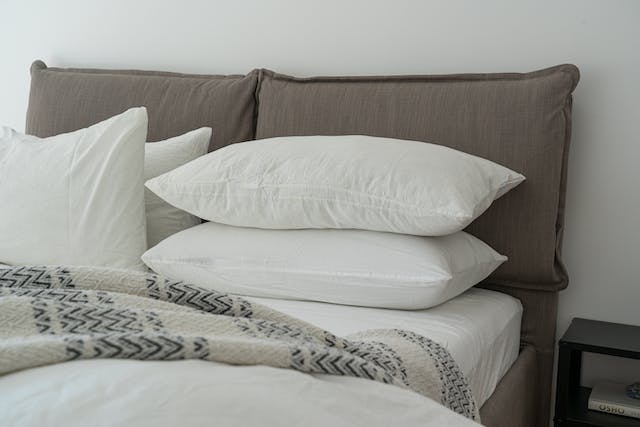
Image source: https://www.pexels.com/photo/white-pillows-on-a-bed-3682240/
The best mattress must be chosen if you want to sleep well at night. Making an informed choice can be very difficult with the variety of mattress kinds on the market. Every kind of mattress has distinctive qualities and features to meet the demands and preferences of different sleepers. In this extensive guide, we’ll look into the advantages and disadvantages of the various mattress kinds while also emphasizing how crucial it is to choose the best mattress possible for your needs.
- Innerspring Mattresses
The innerspring mattress is a form of mattress that has been around for a long time and is still very popular today. They are built with a support system made of steel coils and a variety of comfort layers on the surface.
Pros: Mattresses with inner springs are renowned for having good airflow and cooling capabilities. Hot sleepers can benefit from the coils’ open design, which allows air to flow freely. Additionally, these mattresses are often less expensive, making them suitable for a variety of budgets.
Cons: Innerspring mattresses’ short lifespan is one of their main disadvantages. Over time, the coils can stop supporting you as well, which would cause sagging and less comfort. Additionally, innerspring mattresses can transfer motion more than other varieties, which can interfere with a couple’s sleep.
- Latex Mattresses
The buoyant and responsive feel of latex mattresses can be attributed to the use of either natural or synthetic latex foam in their construction.
Pros: Mattresses made of latex are recognized for their extraordinary toughness. They provide long-term value because they can endure up to 15 years. Environmentally friendly options include those made of natural latex. These mattresses offer superb comfort and support, following the natural contours of the body without imparting the sinking sensation associated with some other mattress kinds.
Cons: The higher price tag of latex mattresses, which might not be suited for individuals on a tight budget, is one potential drawback. Additionally, some people can be allergic to latex, so it’s important to take this into account while selecting a mattress.
- Memory Foam Mattresses
The capacity of a memory foam mattress to relieve pressure and mold the shape of the body of the sleeper has contributed to its meteoric rise in popularity over the past few years.
Pros: These types of mattresses are good at reducing pressure points, making them a great option for those who suffer from chronic pain or who want a luxurious, cradling feeling. Additionally, they lessen motion transmission so that even if one partner moves during the night, the other person is not disturbed and couples sleep peacefully at night.
Cons: The heat retention of this foam mattresses is one possible disadvantage. For people who sleep hot, the dense foam can trap heat, making them uncomfortable. Additionally, some people could find it difficult to change positions on memory foam because of the sinking sensation, and there might not be enough edge support.
- Hybrid Mattresses
The support of innerspring coils is combined with the pressure relief and comfort of layers of memory foam or latex in hybrid mattresses. The goal of this combination is to generate advantages that are beneficial to both parties.
Pros: Coil support and pressure relief from foam or latex are used in hybrid mattresses to provide a balanced experience. They are a flexible option for various sleepers because they are made to accommodate a wide variety of sleeping habits. Hybrid mattresses’ coil systems improve airflow and assist in temperature control.
Cons: The increased price of hybrid mattresses in comparison to innerspring beds is one possible drawback. In hybrids, the comfort layers can degrade more quickly than the coil support system, which can reduce overall longevity.
- Airbed Mattresses
Airbed mattresses are one of a kind because they provide the user with the ability to modify the level of firmness by inflating or deflating individual air chambers.
Pros: The best feature of airbed mattresses is their adjustable firmness. Couples with differing demands can use the mattress together because it can be customized to their particular comfort preferences. Airbeds typically have good longevity and are fairly simple to maintain.
Cons: When changing the stiffness, airbed mattresses could make noise, which can be bothersome at night. Additionally, there is a chance that the air chambers will malfunction or leak, which could lead to an uneven sleeping surface. Additionally, airbeds are frequently pricey.
Conclusion
The best mattress for a particular person will depend on their preferences and needs. Every mattress type has a different mix of benefits and drawbacks to accommodate various sleeping habits and financial constraints. Although they are reasonably priced and breathable, innerspring mattresses cannot be very durable. Although they are more expensive, latex mattresses excel in strength and support. Mattresses made of memory foam offer good pressure relief but can trap heat. With the combination of coils and comfort layers, hybrid mattresses provide a balanced approach. Although they can be noisy, airbed mattresses allow for variable firmness. Waterbed mattresses have a distinctive, buoyant feel, but they also need special maintenance.


